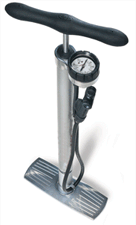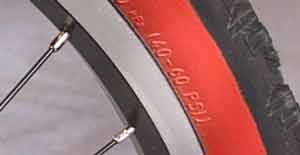Inflate your tires before every ride for more fun
The easiest way to keep your bicycle running well is checking tire pressure before every ride. Properly inflated tires ride great, last long and resist flats. Plus, keeping the tires pumped prevents wheel damage should you hit a rock or pothole while riding. Bent wheels hinder braking and cost a pretty penny to repair.
|
|
Fortunately, checking tire inflation is simple once you have the only tool required: a bicycle tire pump (don't use your local gas station pressure hose because it can overinflate and damage tires). Bike shops sell quality pumps (about $30 to $60) that are easy to use and safe. You might also have a battery-powered inflator for your car that will work if it reaches sufficient pressures. It's best if your pump fits both bicycle valves (Schrader and Presta; the shop will understand) and sports a built-in gauge, which makes it easy to get the pressure right. |
Pressure Check
How do you know how much air to put in your tires? On most tires, the recommended pressure is printed on the sidewall. It's often written as a range, such as "90 to 115 psi (pounds per square inch)," which appears on some high-pressure road tires. You can experiment within this range to find what feels best for you. Less pressure offers a more comfortable ride and more air means less rolling resistance. Many cyclists opt for the best of both worlds and run 100 to 105 psi in their skinny road tires.
|
|
If you're inflating 26-inch tires (common on comfort and off-road bikes), you may find that the pressure range is wider, say "35 to 60 psi." This is because these tires can be used on and off road. For the former, 60 psi is about right because it rolls optimally on pavement. Off road, however, 35 to 40 psi is much more appropriate because it absorbs the bumps, rocks and roots better and offers greater traction for control and handling. |
Air Time
Inflating a tire is as simple as attaching the pump head to the valve and pumping. You'll need to unscrew and remove the valve caps first if your tubes have them. And, if you have Presta valves (they have a knurled tip and are also called "French" valves), you'll need to open the valve by unscrewing and depressing the tip just long enough to let a tiny amount of air out (remember to close it after pumping, too).
Then, attach the pump and start stroking, stopping when the gauge shows that you've reached the recommended pressure. Repeat with the other tire. And you thought bicycling only exercised your legs!


